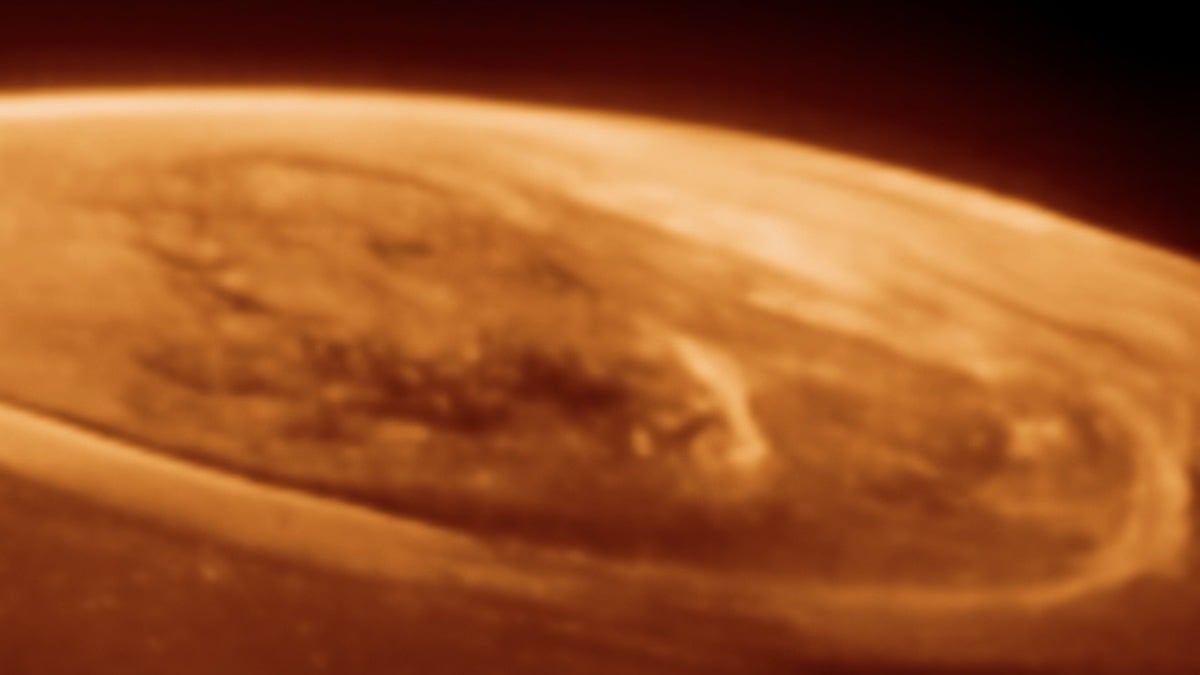Astronomers have zoomed in on Jupiter‘s poles to get a better look at the gas giant planet’s auroras — 100 times brighter than the Northern Lights on Earth.
These alien light shows are not only humongous compared to the ones people are used to seeing in our own skies, but also, they’re powered by an extra source. Jupiter’s strong magnetic field reels in charged particles from its immediate space environment. That means it’s not just grabbing solar wind from the sun to create these luminous displays but particles spewed from nearby Io, one of Jupiter’s 97 moons and the most volcanically active world in the solar system.
A team of scientists used the James Webb Space Telescope, a partnership of NASA and its European and Canadian counterparts, to study the auroras. What they found was a cause-and-effect puzzle: When they zoomed in with Hubble, which can detect ultraviolet light, they thought they’d find signs of the incoming electrons bombarding Jupiter’s upper atmosphere, said Jonathan Nichols, the lead researcher from the University of Leicester in the United Kingdom.
But that’s not what they got.
“What we’re seeing is an incredibly bright afterglow with not much evidence of the original impact,” Nichols told Mashable.
A NASA probe has just spilled secrets about Jupiter and a fiery moon
The Space Telescope Science Institute in Baltimore, which operates the Webb and Hubble telescopes, released a video of Jupiter’s tempestuous roiling auroras, which you can watch above.
For three decades, scientists have delved into how Jupiter, Saturn, and Uranus interact with space by looking at light emitted from charged molecules in their upper atmospheres. Recently, astronomers even got a glimpse of Neptune’s strange auroras. These studies help scientists understand what’s going on high above a planet’s surface and deep within its magnetic field.
Mashable Light Speed
When the sun blasts out radiation, charged particles travel along a planet’s invisible magnetic field lines. When these particles strike gases, they heat up and glow. The results are colorful light displays.
On Earth, the colors differ depending on the type of atmospheric gas and its altitude. Oxygen glows red or blue, while nitrogen can create green, blue, or pink. The recent strong solar storm conditions — a byproduct of the sun being at solar maximum — are causing auroras around the North Pole to sprawl, allowing people who live farther south to see them.
Regarding Jupiter’s auroras, scientists were interested in discovering how quickly the light displays flickered, expecting them to fade in and out over 15 or more minutes. Instead, they saw speedy, erratic shifts. The whole auroral region seemed to be “fizzing and popping” like a soda, changing on a timescale of seconds. These findings were published this week in the journal Nature Communications.

On the left, dancing lights on Jupiter are hundreds of times brighter than those in Earth’s Northern Lights. On the right, the aurora is layered over a James Webb Space Telescope image of Jupiter to indicate its location and scale.
Credit: NASA / ESA / CSA / STScI / Ricardo Hueso / Imke de Pater / Thierry Fouchet / Leigh Fletcher / Michael H. Wong / Joseph DePasquale / Jonathan Nichols / Mahdi Zamani
At the heart of this study is a molecule called trihydrogen cation. (For the record, it sounds like “CAT-eye-on,” not the last two syllables of “vacation.”) When particles have enough energy to rip an electron off a hydrogen molecule, the mangled molecule rapidly reacts with other hydrogen and forms the special molecule. Before trihydrogen cation is destroyed, it gives off infrared light. That’s what Webb observed, Nichols said.
Knowing how quickly trihydrogen cation dissipates matters to scientists because of the role it would play in how Jupiter’s upper atmosphere is heated and cooled. But the researchers simply don’t know how Webb detected the exceedingly bright light of the molecule without ample high-energy particles detected to create it in the first place.
“The explanation currently eludes us,” Nichols said. “Either the particles can in fact rain down in high numbers without requiring much acceleration, or there is something about Jupiter’s auroral atmosphere and generation of aurora missing from our calculations.”
The team will continue to study the paradox of Webb and Hubble’s data with follow-up observations. Their work may help the European Space Agency’s Jupiter Icy Moons Explorer spacecraft, or Juice. The mission is intended to focus its research on Europa, Callisto, and particularly Ganymede, three large moons orbiting the gas giant planet a half-billion miles away. These moons have intrigued scientists for years because they’re thought to have liquid oceans trapped beneath icy shells.
The spacecraft, launched two years ago, is expected to reach Jupiter in 2031.
